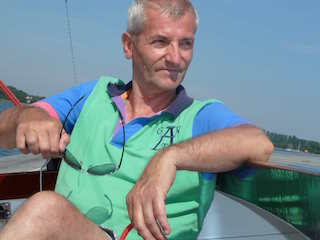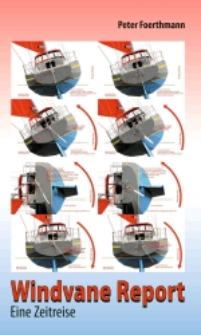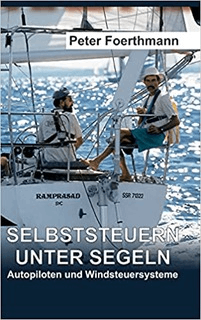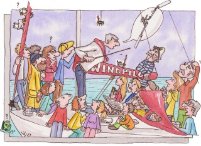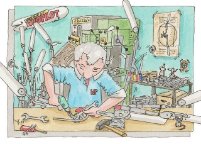COMMENTS – COMPARISON – EXPERIENCES ABOUT WINDPILOT PACIFIC
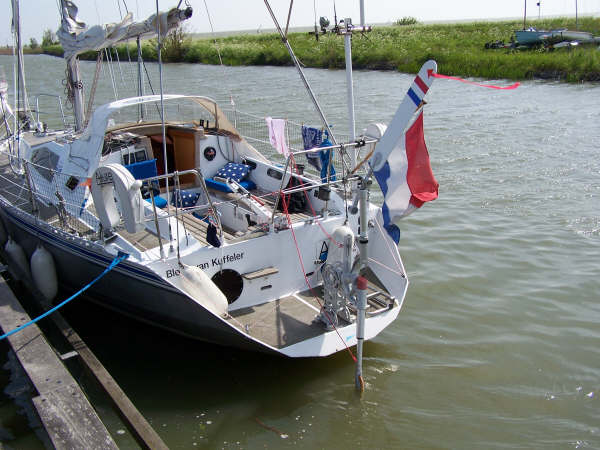
I’m considering a Windpilot Pacific for an Ovni 30. Any comments from existing users welcomed
Thank you,
David
——————
I think you will only find very satisfied users, I am one anyway,( which is also usually true for most other brands of wind vanes).
FWIW, in my marina there is a small ovni (possibly a 30?) with a windpilot, they have a couple of round atlantic trips, they had a broken wooden pendulum blade replaced by a piece of something-wood from inside the boat.
Roberto
——————-
I have used Windpilot Pacific on two boats, a Rival 34 and a Jeanneau 42 and a Windpilot Pacific Light on a UFO27. I have also used an Aries and a Monitor on two different long keel boats. Of all the Windvane Steering systems I’ve used I like the Windpilot best, mainly because of the way it bolts onto the transom and doesn’t move. Of all the systems I’ve tried it seems to be the most robust. I had a complete knock down mid Atlantic in a F10 with the Windpilot Pacific Light and it was the only thing above decks that was not damaged, although it was knocked off course.
Glayva
——————-
One the plus points for me is the simplicity of the bracketing/mounting for the Windpilot, especially for scoop shaped transoms. Also keen to hear about maintenance tips learned from real world experience (in addition to the items provided by Windpilot user manual)!
——————-
Only positives from me, I have a WindPilot Pacific fitted that has done many miles of offshore sailing. Much more powerful and better in light winds than the Hydrovane I have also used (although the Hydrovane does has it’s benefits such as emergency steering). The Monitor is functionally similar and works just as well but is heavier, harder to mount/dismount (if you plan to do that semi-regularly) and is visually not as attractive IMO.
You will not be disappointed with a WindPilot.
——————–
An excellent bit of kit, as others have said. I did an Atlantic circuit with one, mostly single-handed, without the sightest problems. In all it sailed around 20,000 miles without a significant malfunction. Peter Forthmann, owner of the company, is a mine of information and was always helpful.
———————
I am a very satisfied owner. Unable to compare with other makes. However one of the most usefull bits of kit we have. Very usefull with an autohelm when motoring.
———————-
I bought a second hand WP Pacific a couple of years ago (eBay). Could not resist a bargain, although it was obvious that it was quite an old unit and was concerned that it would be problematic to get back to a serviceable condition. However, there was zero corrosion and it all came apart and went back together with no problems. All of the stainless bolts had been coated with lanolin at manufacture which proved to be very effective. Contact with Peter F. confirmed that it was a mid 80s model. Very well engineered and obvious that everything is over specified to cope with extreme conditions. Fitting was very straightforward and it performs faultlessly down to F2 and about 2 kts boat speed. Thoroughly recommend. Boat is a Varne 27.
———————
I have a Windpilot on my Rustler 36 .It has been fantastic, it helmed for 85% of the time on my trip to the Azores. It must be 14 years old now but has needed very little maintainance.
———————
I was shipmates on an S&S Swan 40 fitted with a Windpilot. It wasn’t bad provided the wind was at least 10kts and hull speed 4kts. It’s inability to work in the lightstuff earned it the nickname of ‚The sulky Hun‘. The poor light weather performance is probably down to the fact it has simple bushes rather than ball bearings like the Monitor. In any event The Windpilot was brilliant compared to the POS Hydrovane that my current boat has.
That’s certainly not my experience, which is that if there’s enough wind to sail, there’s enough for the Windpilot to operate. Obviously it’s crucial that there’s no binding in the systen, but equally that it’s installed absolutely correctly. The angle of installation of the gear is particularly important…I’ve helped a couple of fellow Windpilot owners tweak there’s in this respect, to good effect. The small sail-cloth ‚tell-tales‘ on the vane also contribute significantly to light airs performance.
Incidentally ‚the sulky Hun‘ is something of a misnomer: the design is British. Mine was called ‚Jeeves‘
———————-
I’m also a great fan of Windpilots having used the Pacific Light and Pacific models. Peter also offers outstanding service in my opinion and goes to particular trouble in making sure you have set it up correctly and that it works as well as he designed it.
———————-
Hi I have used a WindPilot Pacific for about 23 years. Have covered about 150,000 miles in that time. The gear has been fitted to our 26′ Warsash One Design for its voyage from UK to NZ, our 32 Hartley for South Pacific and our current Saga Saltram 40 for North and South Pacific and sub Antarctics. A wide variety of vessel types and sailing conditions.
The gear is excellent in both strong and light winds. In light winds it is important (in my opinion) to ensure the wind sensing vane is balanced well and has a streamer from its top end to help it catch the wind. Balance of the vessels and sails is always important. In general I would say if the gear isn’t working then the operator is doing something „wrong“. The „wrong“ may be not balancing the sails, over pressing the vessel, not maintaining the windpilot properly or has expectations of a wind steering system that is pre-emptive rather than reactive.
Being a very simple design it is easy to see and understand what is going on with it. The ruggedness of construction is supreme and our only breakages have been when the gear has been hit by other vessels at speed. Service from Peter has been excellent and amazingly fast. On three separate occasions I have been hit by other vessels when berthed. Each occasion needed spare parts of some kind (we are talking a 5 knot collision not a gentle tap). Peter got these spares to me within days in the various parts of the world I was in. Great gear, great service.
I have sailed with Monitor, Aries, Plastimo Navik and Hydrovane. I personally find WindPilot the best all round.
enjoy the sailing
———————
I started with an ‚Aeries‘ and found it needed a fair bit of wind to make it work properly and I was constantly greasing the mechanism
ON the next boat (40 ft steel ketch) I installed a new WindPilot and got on well with it – after a couple of years the plastic separators became swollen and the guy at Windpilot replaced them all FOC.
On the next boat – Moody 36 I installed a new Hydrovane and found it was even better than the Windpilot – it took me round the world without any failures except the material on the vane rotting in the sun so I had a few made in a sail loft for £10 with nice colours.
The big advantage of the Windpilot is that the ‚rudder‘ folds up easily – it is a bigger issue to remove the Hydrovane rudder but I am about to install a new Hydrovane in Paw Paw rather than a Windpilot…
michael
———————–
Certainly. As always on the forum purely my opinions and thoughts.
Navik: Had this on the 26′ WOD to start with. Great gear and realy quite a good system of getting good power from a small upper part (i.e. servo assisted pendulum). Links/ universal joints were plastic and prone to breakage. They were difficult to jury rig (simply carry more spares). The quick release on the water blade released when I hit about 6 knots, and involved leaning over the back of the boat to reset.. Water blade could not be permanently rigged clear of water with out removing it from the mounting (which involved leaning over the side). Overall a good cheap gear for small boats where weight is a problem and you don’t mind leaning over the side. The overall strength of the unit was „lite“.
Hydro vane: The gear was complicated to jury if ever needed (I never needed to though) less sensitive than servo pendulum gear and needed an even better balanced vessel. Sleek and simple with minimal exposed parts. Overall just not as quick to respond as other gears. Great to have the additional rudder and remove wer and tear from main rudder bearings.
Aries: Simple gear but quite a lot of frame work and possible bits to get damaged. Steered well. safety device on water blade involved snapping a sacrificial tube which then required leaning over the side to replace. Had built in rope sheaves which required a bit more maintaining than a block as the aluminum/stainless interface caused some dry corrosion.
Monitor. Smart and similarin some ways to Aries. Worked well, lots of frame work, and not easiest to reset tripped water blade.
Overall I like the windpilot although I would love to get the next model up with own rudder…..dreams…. Overall reasons are I remain inside the guardrails at all times, can set and rest the gear easily, robust and simple castings and controls, excellent service and build quality.
cheers





